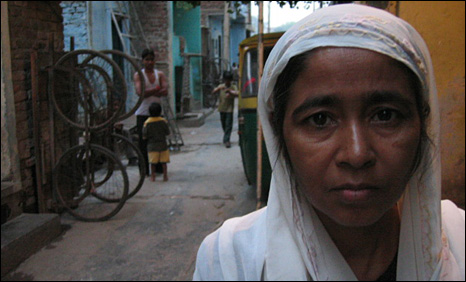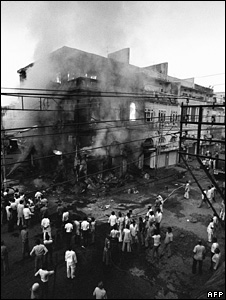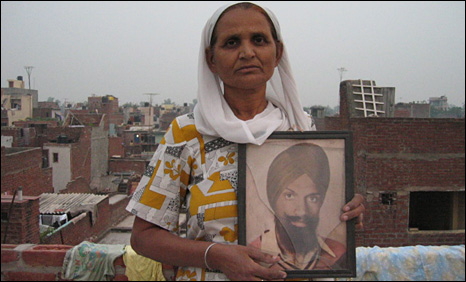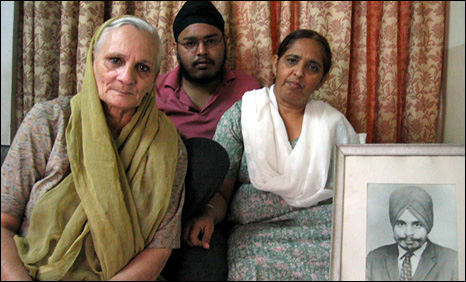BBC NEWS | South Asia | Delhi 1984: Memories of a massacre
Survivors have had little justice. Only 20 people have been convicted for the killings (Photo: Soutik Biswas).
Nearly 3,000 members of India's Sikh community were massacred after the assassination of Prime Minister Indira Gandhi by her two Sikh bodyguards on 31 October 1984. Rahul Bedi, one of the first journalists to reach the affected areas in the capital, Delhi, recalls events.
The 25th anniversary of Indira Gandhi's assassination revives stark memories of some 3,000 Sikhs killed brutally in the orderly pogrom that followed her killing.
The wave of ethnic cleansing which raged unhindered across the country, especially in Delhi, after Mrs Gandhi was shot dead ended only with her cremation on 2 November.
During these three days droves of Sikhs were determinedly hunted down by Hindu mobs from their homes, corralled and slaughtered like animals.
The trigger for Mrs Gandhi's killing was the storming of the Golden Temple in Sikhism's holy city Amritsar four months earlier to flush out Sikh militants fighting for an independent homeland of Khalistan or Land of the Pure.
Sikh shops and establishments were targeted and burnt
The heavily-armed militants - many of them former soldiers - had barricaded themselves inside the temple and were dislodged only after three days of bitter fighting. Some 1,000 people, including women and children pilgrims and about 157 soldiers, died.
Tanks too were employed to end the siege, leaving Sikhs highly aggrieved.
The eventual and possibly avoidable storming of the Golden Temple generated a wave of violence leading to Mrs Gandhi's assassination, the anti-Sikh riots and a vicious insurgency across Punjab that was eventually stamped out by the military around 1993, although not without widespread human rights abuses.
But the 1984 Delhi riots rocked the world, more so for the state's direct involvement and public justification of the blood-letting.
'Earth Shakes'
Reacting to the continuing Sikh killings in Delhi and other places, newly appointed Prime Minister Rajiv Gandhi declared at a massive rally in the capital that "once a mighty tree falls, it is only natural that the earth around it shakes".
One of the worst massacres took place in two narrow alleys in the city's poor Trilokpuri colony where some 350 Sikhs, including women and children, were casually butchered over 72 hours.
Nearly 3,000 Sikhs were killed in the massacres (Photo: Soutik Biswas)
The charred and hacked remains of the hundreds that perished in Trilokpuri's Block 32 on the smoky and dank evening of 2 November 1984 were stark testimony to the unimpeded and seemingly endless massacre.
Soon after news of Mrs Gandhi's killing by her Sikh bodyguards spread, Hindu mobs swung into action - like they did elsewhere in the city armed with voters' lists - in Trilokpuri against the low caste Sikhs inhabiting one-roomed tenements on either side of two narrow alleyways barely 150 yards long.
With local police connivance they blocked entry to the neighbourhood with massive concrete water pipes and stationed guards armed with sticks atop them.
For the next three days marauding groups armed with cleavers, scythes, kitchen knives and scissors took breaks to eat and regroup in between executing their bloodthirsty mission.
Sikhs were killed in the main railway station (Photo: Ashok Vahie)
When as a reporter then with the Indian Express newspaper I along with two other colleagues visited the area on the eve of Mrs Gandhi' funeral, both lanes were littered with bodies, body parts and hair brutally hacked off, forcing us to walk precariously on tip-toe.
It was impossible to place one's foot flat on the ground for fear of stepping on either a severed limb or a body.
Earlier in the day two policemen on a motorcycle had emerged from Block 32 and reassured us that shanti or calm prevailed inside it and no untoward incident had occurred.
A few hours later on returning to the spot we saw that the entire area was awash with blood, a large proportion of it black coagulated mounds over which flies buzzed lazily.
Abject Terror
It was also piled high in the open drains on either side of the tenements, never efficient at the best of times, alongside other human remains.
As we walked through this implausible slaughter in the light of hurricane lamps provided by some residents, the complete silence despite the large mob surrounding us was eerie.
No one spoke and nothing, except the bizarre, dancing shadows moved during this surrealistic interlude.
Even one of the only survivors - a young polio-afflicted mother - holding her new born in her arms gazed sightlessly upon us.
Her blank look momentarily changed into one of abject terror as we bent down to take her child to whom she fiercely clung.
She probably took us to be the butchers who had massacred her entire family piled up high in the room behind her.
A whimper led us to a barely conscious young Sikh, hiding under a heap of bodies, his slashed stomach wrapped crudely around with a turban.
Riot victims have been waiting for justice for 25 years (Photo: Soutik Biswas)
All he wanted was water, parched after over 36 hours of concealing himself under the mound of corpses and bleeding steadily. He died soon after in hospital.
Some doors down a two-year-old girl, unmindful of the bodies, walked lazily over to us holding out her arms asking to be taken home.
Unfortunately, she was home; but one littered with the bloated bodies of her parents and siblings killed two nights earlier.
Police arrived in Trilokpuri 24 hours later when the Indian Express revealed the horrific massacre.
Sadly, there were no Sikhs left to protect.
Two inquiry commissions and seven investigative committees into the 1984 Sikh riots later no one has been held guilty for the Trilokpuri killings.
Of the 2,733 officially admitted murders, only nine cases have so far led to the conviction of 20 people in 25 years; a conviction rate of less than 1%.
But Manmohan Singh's elevation to India's prime minister in 2004 was looked upon by the flamboyant Sikh community as the vindication of its destiny of being born to rule.
Previous transgressions by his Congress party were forgiven but not forgotten and his casually tied trademark blue turban represented a collective crown for the enterprising but persecuted Sikh community.
Mr Singh, they said, was king.
Rahul Bedi is based in Delhi and works as the India correspondent for Jane's Defence Weekly and the Irish Times. During the 1984 riots he was with the Indian Express.




Survivors have had little justice. Only 20 people have been convicted for the killings (Photo: Soutik Biswas).
Nearly 3,000 members of India's Sikh community were massacred after the assassination of Prime Minister Indira Gandhi by her two Sikh bodyguards on 31 October 1984. Rahul Bedi, one of the first journalists to reach the affected areas in the capital, Delhi, recalls events.
The 25th anniversary of Indira Gandhi's assassination revives stark memories of some 3,000 Sikhs killed brutally in the orderly pogrom that followed her killing.
The wave of ethnic cleansing which raged unhindered across the country, especially in Delhi, after Mrs Gandhi was shot dead ended only with her cremation on 2 November.
During these three days droves of Sikhs were determinedly hunted down by Hindu mobs from their homes, corralled and slaughtered like animals.
The trigger for Mrs Gandhi's killing was the storming of the Golden Temple in Sikhism's holy city Amritsar four months earlier to flush out Sikh militants fighting for an independent homeland of Khalistan or Land of the Pure.
Sikh shops and establishments were targeted and burnt
The heavily-armed militants - many of them former soldiers - had barricaded themselves inside the temple and were dislodged only after three days of bitter fighting. Some 1,000 people, including women and children pilgrims and about 157 soldiers, died.
Tanks too were employed to end the siege, leaving Sikhs highly aggrieved.
The eventual and possibly avoidable storming of the Golden Temple generated a wave of violence leading to Mrs Gandhi's assassination, the anti-Sikh riots and a vicious insurgency across Punjab that was eventually stamped out by the military around 1993, although not without widespread human rights abuses.
But the 1984 Delhi riots rocked the world, more so for the state's direct involvement and public justification of the blood-letting.
'Earth Shakes'
Reacting to the continuing Sikh killings in Delhi and other places, newly appointed Prime Minister Rajiv Gandhi declared at a massive rally in the capital that "once a mighty tree falls, it is only natural that the earth around it shakes".
One of the worst massacres took place in two narrow alleys in the city's poor Trilokpuri colony where some 350 Sikhs, including women and children, were casually butchered over 72 hours.
Nearly 3,000 Sikhs were killed in the massacres (Photo: Soutik Biswas)
The charred and hacked remains of the hundreds that perished in Trilokpuri's Block 32 on the smoky and dank evening of 2 November 1984 were stark testimony to the unimpeded and seemingly endless massacre.
Soon after news of Mrs Gandhi's killing by her Sikh bodyguards spread, Hindu mobs swung into action - like they did elsewhere in the city armed with voters' lists - in Trilokpuri against the low caste Sikhs inhabiting one-roomed tenements on either side of two narrow alleyways barely 150 yards long.
With local police connivance they blocked entry to the neighbourhood with massive concrete water pipes and stationed guards armed with sticks atop them.
For the next three days marauding groups armed with cleavers, scythes, kitchen knives and scissors took breaks to eat and regroup in between executing their bloodthirsty mission.
Sikhs were killed in the main railway station (Photo: Ashok Vahie)
When as a reporter then with the Indian Express newspaper I along with two other colleagues visited the area on the eve of Mrs Gandhi' funeral, both lanes were littered with bodies, body parts and hair brutally hacked off, forcing us to walk precariously on tip-toe.
It was impossible to place one's foot flat on the ground for fear of stepping on either a severed limb or a body.
Earlier in the day two policemen on a motorcycle had emerged from Block 32 and reassured us that shanti or calm prevailed inside it and no untoward incident had occurred.
A few hours later on returning to the spot we saw that the entire area was awash with blood, a large proportion of it black coagulated mounds over which flies buzzed lazily.
Abject Terror
It was also piled high in the open drains on either side of the tenements, never efficient at the best of times, alongside other human remains.
As we walked through this implausible slaughter in the light of hurricane lamps provided by some residents, the complete silence despite the large mob surrounding us was eerie.
No one spoke and nothing, except the bizarre, dancing shadows moved during this surrealistic interlude.
Even one of the only survivors - a young polio-afflicted mother - holding her new born in her arms gazed sightlessly upon us.
Her blank look momentarily changed into one of abject terror as we bent down to take her child to whom she fiercely clung.
She probably took us to be the butchers who had massacred her entire family piled up high in the room behind her.
A whimper led us to a barely conscious young Sikh, hiding under a heap of bodies, his slashed stomach wrapped crudely around with a turban.
Riot victims have been waiting for justice for 25 years (Photo: Soutik Biswas)
All he wanted was water, parched after over 36 hours of concealing himself under the mound of corpses and bleeding steadily. He died soon after in hospital.
Some doors down a two-year-old girl, unmindful of the bodies, walked lazily over to us holding out her arms asking to be taken home.
Unfortunately, she was home; but one littered with the bloated bodies of her parents and siblings killed two nights earlier.
Police arrived in Trilokpuri 24 hours later when the Indian Express revealed the horrific massacre.
Sadly, there were no Sikhs left to protect.
Two inquiry commissions and seven investigative committees into the 1984 Sikh riots later no one has been held guilty for the Trilokpuri killings.
Of the 2,733 officially admitted murders, only nine cases have so far led to the conviction of 20 people in 25 years; a conviction rate of less than 1%.
But Manmohan Singh's elevation to India's prime minister in 2004 was looked upon by the flamboyant Sikh community as the vindication of its destiny of being born to rule.
Previous transgressions by his Congress party were forgiven but not forgotten and his casually tied trademark blue turban represented a collective crown for the enterprising but persecuted Sikh community.
Mr Singh, they said, was king.
Rahul Bedi is based in Delhi and works as the India correspondent for Jane's Defence Weekly and the Irish Times. During the 1984 riots he was with the Indian Express.









